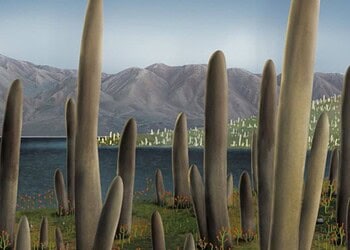Researchers at the Department of Energy’s Oak Ridge National Laboratory (ORNL) are hacking the plant-fungi relationship to help us grow better, more productive, more resilient crops.

The team has identified a specific gene that controls the symbiotic relationship between plants and fungi in the soil and used it to facilitate symbiosis in a plant species that typically resists such fungi. The research paves the way towards the development of food and bioenergy crops that can withstand harsh growing conditions, resist pathogens and pests, require less chemical fertilizer, and produce more plentiful per acre.
Magic ‘shrooms
“If we can understand the molecular mechanism that controls the relationship between plants and beneficial fungi, then we can start using this symbiosis to acquire specific conditions in plants such as resistance to drought, pathogens, improving nitrogen and nutrition uptake and more,” said ORNL molecular geneticist Jessy Labbe, the paper’s first author.
“The resulting plants would grow larger and need less water and fertilizer, for instance.”
The fungi Labbe refers to are known as mycorrhizal fungi (a mycorrhiza is a symbiotic association between a fungus and a plant), and they form a sheath around plant roots that benefits both participants. An estimated 80% of plant species have mycorrhizal fungi associated with their roots.
The plant receives water and raw minerals, particularly phosphorus, and ‘trades’ carbon-rich compounds in return. The fungal structure extends much farther than the plant host’s roots, allowing it to tap into a larger volume of soils. There is also some evidence suggesting these fungi also communicate with neighboring plants to limit the spread of pathogens and pests.Their relationship is so close that these fungal helpers may have been what allowed the ancient colonization of land by plants.
Given the importance of this partnership, biologists have been really eager to find the genetic mechanisms which underpin it. The current discovery is the culmination of 10 years of research at the ORNL and partner institutions that focused on producing better bioenergy feedstock crops such as the poplar tree (Populus).
Together with improvements in genomic sequencing, quantitative genetics, and high-performance computing over the last decades, the team drew on the ORNL data to narrow down the search to a particular receptor protein, PtLecRLK1. Once they had identified the likely candidate gene, the researchers took to the lab to validate their findings. Lab testing later confirmed that they were onto the right gene.
The researchers chose Arabidopsis, a plant known to treat the mycorrhizal fungus L. bicolor as a threat for the experiments. They engineered a version of this plant to expresses the PtLecRLK1 protein and then inoculated the plants with L. bicolor. The fungus completely enveloped the plant’s root tips, they report, forming a fungal sheath indicative of symbiote formation.
“We showed that we can convert a non-host into a host of this symbiont,” said ORNL quantitative geneticist Wellington Muchero, a co-author of the paper. If we can make Arabidopsis interact with this fungus, then we believe we can make other biofuel crops like switchgrass, or food crops like corn also interact and confer the exact same benefits. It opens up all sorts of opportunities in diverse plant systems. Surprisingly, one gene is all you need.”
Jerry Tuskan, the director of the DOE’s Center for Bioenergy Innovation (CBI), which supported this research, calls the results “remarkable”, saying it paves the way towards new bioenergy crops that can thrive “on marginal, non-agricultural lands.”
“We could target as much as 20-40 million acres of marginal land with hardy bioenergy crops that need less water, boosting the prospects for successful rural, biobased economies supplying sustainable alternatives for gasoline and industrial feedstocks,” he concludes.
The paper “Mediation of plant–mycorrhizal interaction by a lectin receptor-like kinase” has been published in the journal Nature Plants.






